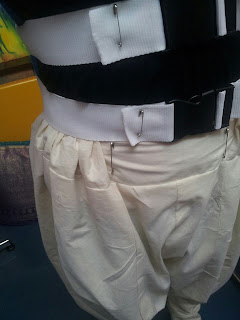First stage - This is the first stage of the back pack. This back pack was based on the back packs created for the moving tides carnival, using very similar construction techniques and following the same lay out. I chose to add an additional strap as this puppet was much bigger and this would help spread the weight evenly . The straps however were to close together and needed separating to spread the weight more. This back pack also needed the poles to come closer together making it more narrow and the plastazote at the sides of the wood needed cut down so straps sat closer to the body.



This shows the new plan of the wood board for the new back pack - this was the closest i could get the poles to sit together allowing enough room to bolt and unbolt the supports when flat packing the costume.
This plan also shows the bottom strap lowered using the same bolt as the bottom pole covers to hold it in place. I also chose to do the same with the top strap taking it the bolts at the right and left top pole covers.
The next alteration the back pack seen was in the shoulder strap system used. The shoulder straps of the back pack were originally going to run across the front of the actor attaching to the two other straps. However by pulling them behind the actors back like a ruck sack style strap this allowed a closer fit to the body at the shoulder points where a lot of weight sits, it also meant the straps could be connected under the back pack tray lifting the pack higher on the actors back and keeping it in the correct place.
After this stage the back pack seen some major rework after the weight of the puppet increased, although things were altered the fundamental techniques of the back pack were kept (the strap system and the narrow line and angles of the poles)
The wood board of the back pack was made longer to help counter balance the top heaviness of the puppet, this meant not all the weight was on the weakest part of the actors back but spread across all of his back. It was also decided more plastazote should be added so the actor has a plastazote piece hugging his hips creating a small back brace at the bottom of the back pack allowing the weight to be spread across his hips as well as his shoulders and then running down his back.
I really do think that by practical research of trial and error and constant discusses with peers and tutors i have succesfully created a back pack that gives the correct support to the actor as well as the puppet. This back pack is definitely tailored to this specific piece of structural costume.














































